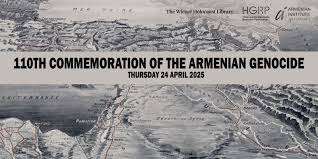110 Years On: Remembering the Kut Siege and the Armenian Genocide

Victoria Abrahamyan
April 2025 marks two significant, though often separately remembered, anniversaries in the history of the First World War. On April 24, we commemorate 110 years since the onset of the Armenian Genocide, perpetrated by the Ottoman ruling elite between 1915 and 1922. Just days later, on April 29, we mark 109 years since the surrender of the British garrison at Kut in Mesopotamia (modern-day Iraq), following a prolonged siege that began on December 5, 1915.
These two major events—the Armenian Genocide and the British defeat at Kut—unfolded in parallel on the edges of the Ottoman Empire, and while distinct in nature, scope, and scale, they were bound by a shared context of imperial collapse and wartime brutality. This article explores the often-overlooked intersections between them, focusing on how the paths of Armenian deportees and British prisoners of war (PoWs), both subjected to forced marches, starvation, violence, and death, converged in profound and tragic ways. The article argues that the surrender of Kut marked a turning point for thousands of Armenian Genocide survivors employed on the Berlin-Baghdad railway which traversed the Syrian desert. Ottoman authorities used PoWs to replace the deported Armenians as forced laborers. By examining the fates of these two distinct groups in tandem, the article makes a contribution to both Armenian Genocide studies and the broader trans-imperial histories of WWI. It highlights the testimonies of the PoWs—an underutilized yet valuable source—as firsthand witnesses to the Armenian massacres. Furthermore, by narrating the suffering of the PoWs—military men typically cast as agents of violence—alongside that of Armenian civilian deportees, the article challenges conventional narratives and reframes both groups as marginalized victims of imperial violence.
Brief history
The Iraqi city of Kut was the site of one of the longest sieges ever endured by a British garrison—lasting 147 days, from December 5, 1915, to April 29, 1916. The surrender was followed by two and a half years of brutal captivity. The siege and surrender at Kut occurred during the British Mesopatomia campaign, which had begun on November 6, 1914—just one day after Britain declared war on the Ottoman Empire. Initially conceived as a limited operation to protect the Anglo-Persian oil refinery at Abadan, the campaign soon escalated into a large-scale military offensive. British forces, largely unprepared for the extreme climate and unfamiliar with the hostile terrain of Mesopotamia, advanced too far, too quickly. Their overreach culminated in a costly defeat on the outskirts of Baghdad and the entrapment of the retreating force at Kut.
Kut was located 250 miles south of Baghdad, on a small peninsula formed by a sharp bend in the Tigris River, near where the Shatt al-Hai connected the Tigris and Euphrates. The besieged force consisted of 3,152 British and 8,455 Indian officers and enlisted men—drawn from the diverse ethnic and religious communities of undivided India— alongside some 3,530 Indian non-combatants. For nearly five months, the troops suffered from disease and starvation. As the siege wore on, starvation became the primary cause of death. Inadequate and rapidly deteriorating rations led to widespread outbreaks of pneumonia, jaundice, dysentery, beri-beri, and scurvy.
On April 29, 1916, after repeated and unsuccessful relief efforts, the British garrison was forced to surrender. What followed was a harrowing ordeal: forced marches spanning more than 1,000 miles under the scorching heat. Ottoman mounted guards drove the PoWs like cattle toward internment camps in Ras al-Ayn, and further into the heart of Anatolia. Most were stripped of their boots and water bottles at the outset. Thousands died along the way—those who collapsed from exhaustion were simply left to die by the roadside. Prisoners were often beaten for attempting to help fallen comrades. In the case of those weakened by dysentery, there were accounts of men being “tied by the wrists or ankles to the pommels of the escort’s saddlers and literally dragged to death. Others had been clubbed and beaten as they stopped by the wayside to answer Nature’s urgent call.”
Of the 2,500 British officers and men captured at Kut, only 700 would eventually return home after the Armistice. The fate of the Indian soldiers remains largely unknown. Some reports suggest that Indian prisoners were still making their way back to India as late as 1924.
During the forced marches, British officers were generally spared the worse conditions endured by the enlisted men. They were interned in towns such as Kastamonu, Yozgad, Chankiri, Kedos and Afionkarahisar—often housed in former Armenian residences confiscated during the Armenian massacres. In contrast, most Hindu and Sikh PoWs were forced into hard labor on the Berlin-Baghdad railway, effectively replacing Armenian deportees who had been massacred the previous year.
The Berlin-Baghdad railway: saviour and slayer
Ras al-Ayn, in particular, became a major labor station for British PoWs after having previously functioned as a key concentration camp and a primary killing site for the Armenians. It is estimated that up to 1.5 million Armenians perished during the Genocide, many as a result of death marches characterized by disease, starvation, exposure and systematic violence. Survivors of these marches were herded into concentration camps in the Syrian desert where they faced inhumane conditions with no food, water, shelter, or sanitation.
The arrival of the British PoWs at Ras al-Ayn coincided with what scholars identify as the “second phase” of the Armenian Genocide, marked by the mass extermination of Armenian deportees who had survived the marches. In the massacres of March 1916 alone, between 150,000 and 200,000 Armenians were killed in the Der Zor–Ras al-Ayn–Mosul triangle.
Following several waves of massacres, thousands of Armenians managed to escape death and found temporary reprieve by working for German railway surveyors, who employed them as a much-needed labor force. However, the arrival of British PoWs in the summer of 1916 effectively sealed the fate of these Armenians laborers. By deploying the PoWs on the railway, Turkish authorities removed the German’s justification for retaining Armenian workers, who were subsequently deported or killed. The first convoy of British prisoners arriving at Ras al-Ayn encountered a group of Armenian deportees, along with Turkish deserters, working on the railway. By the time they reached the train station in Islahie, Bishop testified to witnessing the final caravans of wretched Armenians, composed of men, women, and children driven out from the village, “to make room for our troops, who would be set to work in their place.” He was informed that the Armenians would be marched off into a waterless spot in the hills, and left there to die.
Along the route from Kut through Baghdad and Mosul, and later at Ras al-Ayn, British PoWs bore witness to the atrocities committed against the Armenian population. Their memoirs and letters contain chilling testimonies: passing through deserted Armenian villages, drinking from wells filled with decomposing corpses, encountering emaciated columns of deportees, and in some cases, directly witnessing mass killings—particularly in and around Ras al-Ayn, one of the epicenters of the Genocide.
British prisoners as eyewitnesses of the Armenian massacres
British PoWs frequently compared their own suffering to that of the Armenian deportees, believing they shared a common fate—defined by starvation, violence, and death in the desert. During their forced marches—particularly beyond Mosul and Nissibin, towards the Amanos Mountains, along the railway line that would later mark the Syrian-Turkish border after WWI—the PoWs passed through countless abandoned Armenian villages. Having left the Tigris behind, they depended on village wells for drinking water—many of which were filled with the decomposing bodies of Armenian victims.
A similar account is provided by Major Sandes, who described a halt west of Mosul, near the eastern tributaries of the River Khabur. There, the PoWs enjoyed what they believed to be clean drinking water—until they discovered that the nearby wells were filled with Armenian human remains. At their next stop General Delamain personally inspected the wells before allowing anyone to drink:
“Since sinister rumours of Armenian massacres were already afloat among us. The state of the well confirmed the rumour. It was half full of the remains of wretched men, women, and little children, done to death by the Turks or by their satellites the Kurds and Arabs. All the way along the line of march from this point to Raas-el-Ain we continually saw deserted villages, for the state of which our guards would offer no explanation.”
One British diarist described the march as becoming more horrific each day, following “a trail of skeletons and corpses—Armenians.” One British medical officer, Bishop, testified:
The country after leaving Mosul had been almost uninhabited, but here there were small villages dotted about. On getting nearer to them, we found that they were deserted; our guards told us they were Armenian villages, and that the people had all been killed earlier in the war. We passed a great many of these awful testimonies to the barbarity of Turkish politics.
In their diaries, British PoWs drew poignant parallels between themselves and the Armenian victims. One British survivor, Wheeler, described the impression of his captors:
With a sad and perplexed look upon his face he refused to believe we were going to be exchanged—no doubt he had in mind the fate of Armenians (Men, women and children) who had also passed that way and were turned out into the desert to die from starvation. I had seen a batch of these unfortunate individuals from across the river being driven out into the desert. From the distance, thinking they might be some of our own men, I called the attention of the Camp Interpreter —a sympathetic Persian—who told me of the atrocities being committed by the Turks.
Reverend Spooner—who spent 16 years in psychiatric care after the Armistice, unable to recognize his wife and children— wrote in his diary on July 6, 1916:
We started to mount the Anti Taurus Mountains. This was the scene of the late terrible massacres of the Armenians, Many Kut-al-Amara officers and men saw the results of these atrocities by the roadside; women and little children with their throats cut, and many mangled bodies.
Another survivor wrote: “These wretches had been driven from their homes and were suffering similar privations to those being experienced by the British troops who were at this time marching into captivity.” Turkish guards also made this connection, referring to both groups as esir —a term that in Turkish implies both “prisoner” and “slave”—and treating them accordingly. Yet, even amidst their own suffering, many British PoWs acknowledged that the Armenians endured far worse. While British prisoners received meager rations, one soldier noted starkly: “Armenians were given nothing.”
Ras al-Ayn, along with other Berlin-Baghdad railway stations in the Syrian desert, soon became a major site of death for the PoWs as well. According to the British Secretary of the PoW Department, approximately 5,000 able-bodied prisoners taken from Kut were transferred to work there, where thousands perished due to exhaustion and maltreatment. The War office estimated that during the 2.5 years of captivity, about 70 % of the British PoWs and 30 % of the Indian troops died. Ras al-Ayn reportedly had the highest mortality rate.
Despite the severity of the PoWs’ suffering, reports of their brutal treatment were largely suppressed in the British press for a considerable time. It was not until June 1917 that The Times raised concerns about their conditions, following the Turkish authorities’ refusal to allow the International Committee of the Red Cross to inspect the camp at Ras al-Ayn.
Although public outcry and diplomatic pressure eventually led to gradual improvements in camp conditions, the inhumane treatment and high mortality rates persisted throughout the remainder of the captivity.
Conclusions
This article has examined the intertwined yet distinct narratives of suffering and survival experienced by the victims of the Armenian Genocide and the British PoWs during the First World War. While many British rank-and-file soldiers endured forced marches, starvation, violence, and slave labour similar to those faced by Armenian deportees, British officers were often interned in homes confiscated from Armenians.
It is vital, however, to recognise the fundamental differences between their experiences. The Armenian deportations were part of a systematic campaign of annihilation. In contrast, although British PoWs suffered extraordinary hardship and cruelty, they were not subjected to a deliberate policy of extermination. Furthermore, the gendered nature of captivity—where British prisoners were exclusively male—meant they were spared the particular atrocities of sexual violence that Armenian women and children endured.
During their forced marches in the spring and summer of 1916, British prisoners witnessed firsthand the aftermath of the Armenian massacres. As the last Armenian survivors were killed or displaced, British PoWs increasingly replaced them as forced labourers on the Berlin–Baghdad railway—a grim symbol of the overlapping tragedies of war and genocide





